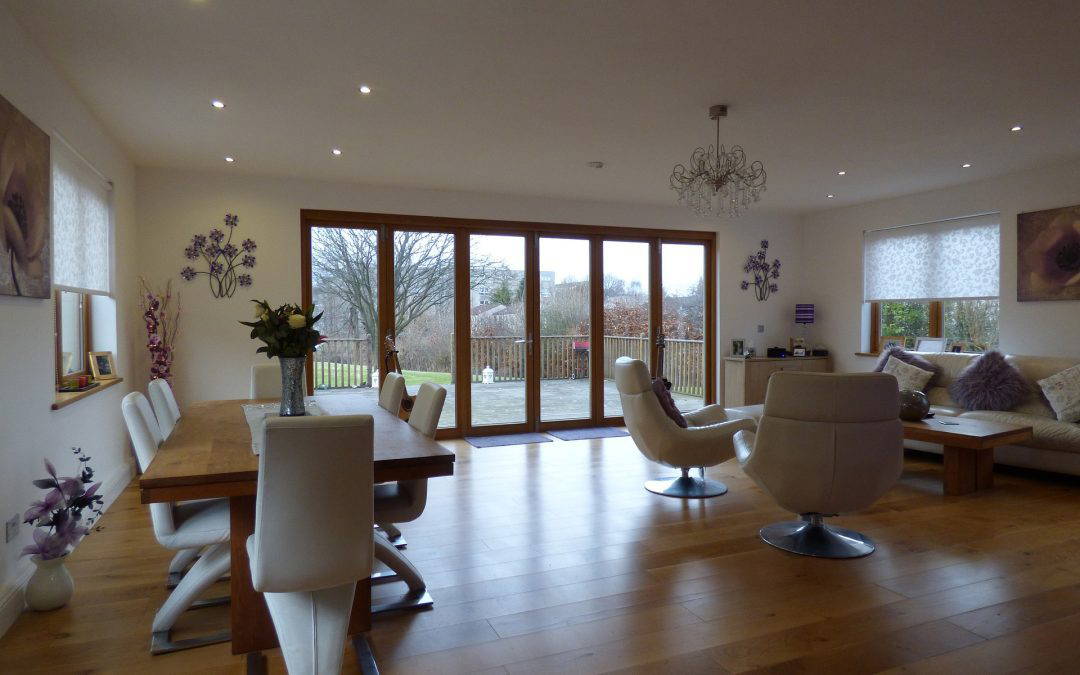Bi-folding doors are a sleek and modern choice for your home. They allow light to flood your interiors and seamlessly blend indoors and outdoors. So if you’re considering bi-fold installation, these are the key things you need to consider.
How many bifold doors do I need?
The size of the opening will determine the number of doors and panels you need. The most popular configurations are three or five panels, as odd numbers give a better look. However, aim for as few panels as possible if you’re framing a beautiful view. And if you need everyday access to the garden, make sure you can open the lead door independently.
Generally speaking, bi-fold panels are between 0.4 – 1 m in width and 1.8 – 2.2 m in height, including the frame. So again, look for a made-to-measure supplier to make the most of your bi-fold installation.
How much will bi-folding doors cost?
The cost of your doors depends on several factors, including materials, labour, size and supplier. For example, you’ll pay more for timber and aluminium doors than uPVC. If you’re creating a custom opening in your space, you’ll also need to factor in the cost of structural beams.
You should also factor in the following:
- Installing threshold drainage to prevent water from entering your home
- Positioning and fixing the panels
- Adding a membrane to prevent leaks
What materials are best for bi-folding doors?
The most popular materials are uPVC, aluminium and timber. However, what you choose will ultimately depend on your budget and aesthetics.
UPVC remains the budget-friendly option. They’re readily available, easy to look after and come in multiple configurations to suit your home. If standard white doesn’t suit your style, you can find uPVC bi-folding doors in various finishes and colours, including on-trend anthracite and natural woodgrain, for a traditional look.
If you love the streamlined aesthetic of slimmer frames, aluminium is lightweight but super-strong. It’s definitely a choice to consider for a strong modern look, but aluminium bi-folds can be expensive and often have long lead times.
Timber bi-folding doors are a beautiful choice for period properties and may be your only option if there are planning constraints where you live. Timber bifold doors can be highly thermally efficient, but they’re also prone to warping and require plenty of upkeep.
Will bi-folds make my room feel cold?
The thermal performance of your doors is critical, so look for the lowest U-value you can afford. For reference, bi-folding doors should be rated 2.0W/(m2k) in new builds and 1.8W/(m2k) for replacement doors. Also, look out for doors rated at BS 6375 Part 1, as these have passed the weather tightness test.
Are bi-folding doors secure?
Bi-folding doors must conform to standards for safety and security, and lead doors must be equipped with a multi-point locking system. In addition, look for locking systems that meet the Police ‘Preferred by Design’ standards.
Tips for buying bi-folding doors
- For ultimate weatherproofing, look for a weathered or rebated threshold to protect your interiors from flooding.
- Make sure the panels are available in the size and configuration you need.
- For families with small children, look for safety features like finger-safe gaskets.
- Check the manufacturer’s guarantee.
- Always check how smoothly the doors slide, fold and stack by visiting the showroom and testing them for quality.
Bi-folding doors from KP Glass & Windows
Stylish bi-folding doors are the best way to connect the indoors with the outdoors. At KP Glass & Windows, we offer an extensive range of colours and finishes, and our made-to-measure service ensures your bi-folds perform seamlessly. To find out more, visit the showroom or contact the team today.

